|
FAQs about Ceriths, Genus Cerithium, Family
Cerithiidae Snails
Related Articles: Gastropods, Sea Slugs, Mollusks, Abalone,
Related FAQs: Marine Snails 1, Marine Snails 2, Marine Snails 3, Marine Snails 4, Snail ID 1, Snail ID 2, Snail Behavior, Snail Selection, Snail Compatibility, Snail Systems, Snail Feeding, Snail Disease, Snail Reproduction, Mollusks, Sea Slugs, Abalone,
|
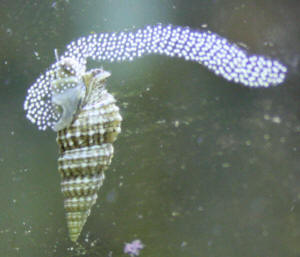
|
|
Id hitchhiking snail please 7/29/18
Hi Crew!
<Dani>
I found this very tiny snail on a liverock, it’s maybe 3mm long...could you
please help ID? Thank you as always! I hope you have a nice day.
Dani
<Is this a Cerith/id? Bob Fenner>
|
.jpeg) |
|
Trematodes came with my snails?
11/13/11
Dear Wonderful WetWeb Crew,
<Kor>
I have a 40 gallon aquarium that has been set up since September.
Specific Gravity is at 1.026 and temp is around 78. I added about
10 Cerith snails from a local fish store a week ago and they have
some wormish hitchhikers.
<Very common>
At first I just saw a few stuck to their shells. Then I picked a
snail off the rock to look at closer and some of these fell out
of inside the shell as well. I have attached pictures that I hope
will help you give me an idea of what they might be.
<Need much more highly resolved, larger pix>
I was thinking of dosing the tank with PraziPro, but thought
I'd try to get some kind of ID from you guys first. They are
about 1/16th of an inch long and reddish brown in color. They
don't appear to swim in the container nor move at all.
I'm slightly puzzled and have never seen this. I didn't
come across it on your website either. The first picture are some
that fell out of the inside of 2 snails into a clear container.
The second is obviously on the snail.
Thank you for any insight you may have on this. It is truly
appreciated.
KJ
<Gastropods/Snails are very often vectors/carriers,
intermediate hosts for worms of various sorts. IF concerned that
these may "be trouble", I would go ahead w/ your
Anthelminthic treatment plans. There is a very large body of
data, writing re various species (esp. of economic or health to
humans consequences)... Some "worms" that get about
this way have complex life cycles and will most likely perish in
an aquarium setting w/o "causing harm". Do a bit of
look/seeing on the Net... perhaps a visit to a large/college
library w/ a life science dept. Cheers and thank you for sharing,
Bob Fenner>
|
|
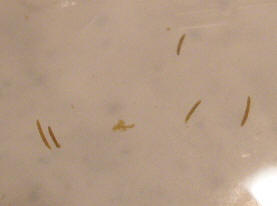 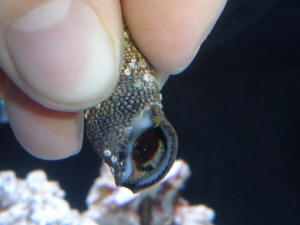
|
|
How Do I Care for Snail Eggs? 5/20/11
5/21/11
Hi,
<Hello Dave, Lynn here today.>
I just want to say I have found your FAQ and articles very
helpful; this is my first question/post though.
<Fire away!>
I found these (see attached pics) on the side of my refugium, I
think they are Cerith snail eggs?
<They certainly appear to be.>
My question: Is there anything I can do to care for them or
ensure their survival?
<I would leave them as is and observe. Their survival, beyond
hatching, is largely dependent upon which species you have. Some
Cerithium spp. (e.g., Cerithium muscarum and Cerithium lutosum)
develop within the egg to the point that when they hatch, they
emerge as crawling snails (method referred to as 'direct
development'). These species have a fairly good chance of
survival within aquaria as long as there's enough food
available, the water quality's okay, and nothing's
preying on them. On the flipside, species such as Cerithium
eburneum and Cerithium litteratum emerge from the egg into a
free-swimming/planktonic larval stage that unfortunately does not
bode well for their survival. In cases such as this, these
'indirect' developers are exposed to all manner of
threat, including filters, skimmers, pumps, etc., as well as
hungry corals, fishes, and other organisms. Beyond that, indirect
developing snails often require specific foods in order to
survive, may be in the water column anywhere from a week or so,
up to almost a year, and require specific cues in order to prompt
the young to settle to the substrate and metamorphose into
miniature versions of the adults. Needless to say, it could
present a real challenge to meet the specific requirements for a
given species. All in all, unless there are hermits, shrimps or
other little 'pickers' and predators within your
refugium, the eggs are actually in a pretty good place. I would
simply keep an eye on them (they'll probably break up/detach
and disappear within a few days) and hope for the best when it
comes to the young. The good news is that whether they survive
and add to the clean-up crew, or serve as a natural source of
nutrition for your livestock, it's going to end up being
beneficial to your system. If you'd like to pursue this
topic/issue further, I'd recommend trying to identify which
Cerithium species you have and learn more about its reproductive
method. If you need more information or assistance, please let
me/us know.>
Dave
<Take care and good luck! Lynn Z>
|
|
[1].jpg) 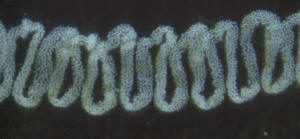
|
|
White Curly String-Like Thing on Glass/Snail Egg ID
5/3/2011
Hi All,
<Hello Amy, our daughter's name is Amy also, but
you're not asking for money, are you? :-)>
I have an odd white, curly, string-like thing on the glass of my
tank.
Actually there are three of them that I can see, the one in the
photo is the largest (3.5 inches). I have attached a photo. In
the picture it almost looks like there is sand in the white
strings, but in person there is no sand (I don't think,
anyway). I have Googled all day but haven't found
anything.
<Looks to me like you have what's called a snail trail.
One of your snails, likely a Cerith, decided to
deposit eggs on the glass.
Take a look at our numerous snail egg ID FAQs here, look for a
match up.
http://www.wetwebmedia.com/SnailEggIDF1.htm>
Tank Info:
Tank has been set up since April 9, 2011
90 gallon DT
30 gallon sump
Lighting :
http://www.vertexaquaristik.com/Products/Lighting/LED/Illumilux/MarinoBianco.aspx
x1 QuietOne 4000 return pump (sump directly below DT,
approximately 4ft head loss)
Two Koralia Evolution pumps flow rate 1050
Octopus 110 Pinwheel Protein Skimmer - on line since April 30,
2011
100 lbs cured live rock added April 9, 2011
60 lbs live sand added April 9, 2011
Have made my own RO/DI water since the beginning - 000 TDS
SeaChem Reef Salt
Refractometer Reads 1.026
Temp - 78.4 (this is normally a tad higher but it is cool and
rainy here today in Cincinnati)
API Saltwater Master Test Kit Reads:
High pH - 8.0
<High pH????>
Ammonia - between 0ppm and 0.25ppm (this has been at 0ppm but
elevated this week, I think shortly after the snails were
added)
NitrAte - 0ppm
NitrIte - 0ppm
Inhabitants:
Hermits and snails added April 29, 2011
Engineer Goby
Hair algae (suggestions on beating this?)
<Go here. http://www.wetwebmedia.com/algaeconMar.htm>
Mr. Goby gets fed a mixture of mysis and brine shrimp thawed in
DT water every other day (although I think my boyfriend sneaks
him food). I have not done any water changes since the tank has
been set up, but I do add about a gallon of fresh RO/DI daily to
top off.
Any and all help is greatly appreciated.
Thank you,
<You're welcome. James (Salty Dog)>
Amy
|
|
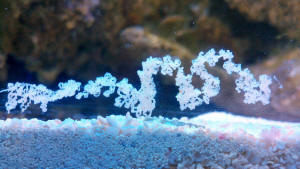
|
Re White Curly String-Like Thing on Glass/Snail Egg ID
5/3/2011
James,
<Amy>
Thanks for your help! I guess my Google description wasn't very
good. From what I read it doesn't sound like the snail babies
are very likely to survive, poor eggs. Also, the High pH is just
what it says on the solution bottle.
<Oh. Just wanted to clarify, thought you may have thought your
pH was high.>
Thanks again for your help!
<You're welcome. James (Salty Dog)>
Oh, and if you are handing out money to everyone named Amy, I will
certainly take some! :)
<None left to hand out. :-( Problem is, my Amy is cuter than a
bug in a rug and it was difficult saying no to her when she gives
you those big sad puppy dog eyes. She is now doing much better than
her father in the last few years. Had landed a very good job at the
Mayo Clinic in AZ. Won't have to worry about her anymore. Geez,
I wish Bob would adopt me.><<Already have. B>>
-Amy |
|
Snail Overpopulation: Likely Juvenile Ceriths -
8/26/10
Hello once again WWM crew.
<Hello Miguel, Lynn here today.>
Have you ever had one of those sleepless nights and you just
wondered what was going on in your tank and you take a peek?
<Oh yes.>
Well I had one of those a couple of nights ago and decided to
check in on my reef tank. I'm glad I did because I noticed a
Teddy bear crab munching away on a lord coral frag,
<Yikes!>
(I was fortunate enough to just pick up the frag and dump the
crab into my refugium)
<You were very lucky indeed to have been able to catch it that
easily.>
.. but I also noticed hundreds of small white snails all over the
LR. I had seen a few of these small snails during the daytime and
I just thought they were baby Cerith snails.
<They could be either juveniles or some other species
entirely. Chances are good that they're harmless. There are
quite a few small, white(-ish), beneficial herbivores. I'd
need to see a couple of high resolution, close-up shots (one
taken from above the snail, the other showing the opening) to
have much of a chance at an ID. >
I had also seen what I thought were immature Cerith snails which
were black with a white tip. I started looking for an I.D and
along the way someone mentioned pyramid snails.
<Yikes, you don't want those. Thankfully, I doubt
that's what you have. Pyrams are typically very small (less
than 5mm), and white to a light brown/tan in color. They
don't have the strongly demarcated white/dark brown/black
shells like I see in your photos. Please see the following link
for more information related to distinguishing Pyrams from other
harmless snails such as Rissoids:
http://www.reefland.com/articles/rho/identify-this-rissoid-and-pyramidellid-snails
>
Do Ceriths start out white? Or do they start with the same colors
as the adults?
<To be honest, I'm not sure. I haven't seen any white
juveniles (of normally dark-shelled species), but that
doesn't mean they're not out there. >
Enclosed are a few pictures. The first one is comparing a Cerith
with the largest of what I'm calling the "immature
Cerith".
<I'm pretty sure that's a Cerith of some sort.
It's a shame the large individual's shell is covered with
so much coralline. There's no way I can compare the surface
texture of the two.>
The second one is of two sizes of the "immature
Cerith?"
<This one threw me for a bit because the shells appear
stockier than a typical Cerith. Thankfully, they look enough like
the snail in photo 1 that I think it's just an issue of
viewing angle. If I hadn't seen that first individual, I
would have looked into the possibility of a Nassarius species or
perhaps a whelk in the genus Pollia, Gemophos, or Cantharus. I
don't think it's any of those, though. I don't see
any long siphons (typical of whelks and Nassarius spp.) and the
combination of surface texture, color, and proportion isn't
quite right. The more I look at all of the individuals (excluding
the white ones), the more I think that what you're seeing are
juvenile Ceriths. If I had to guess, I'd say they're
probably Cerithium lutosum (aka the Dwarf Variable Cerith), due
to shell texture, whitish tips, and the fact that they reproduce
well in aquaria. Naturally, I have to throw in the caveat that
there are many Cerithium spp. out there, along with several
closely related genera, so the possibilities are many. The bottom
line is that I don't think you have anything to worry about.
>
..and the last one there two of the small white snails (9 and 3
o'clock)
<Again, these could be very young snails or something else
entirely. Whatever they are, chances are good that they're
harmless.>
..and two of the black/white snails (11 and 6 o'clock). Do I
need to be concerned about these snails if they are not
Cerith?
<I wouldn't be, not unless you're noticing
damage/injury to livestock.>
And if they are not Cerith, any idea as to what they are?
<There are many possibilities. I'd need some good photos
and a bit more information (how big they are and where they
originated, if possible). Please see the following links for
comparison:
Cerithium lutosum: http://www.gastropods.com/0/Shell_2560.shtml
More Ceriths:
http://www.gastropods.com/Taxon_pages/TN_Family_CERITHIIDAE_CERITHIINAE.shtml
Gemophos, Pollia, Cantharus, for comparison:
http://www.gastropods.com/Taxon_pages/TN_Family_BUCCINIDAE_PISANIINAE.shtml
>
As always thank you for your help in all these fishy matters,
<You're very welcome.>
Miguel Miguel
<Take care, Lynn Z>
|
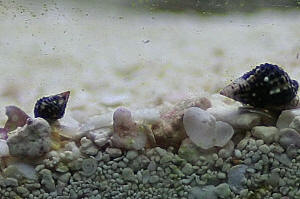 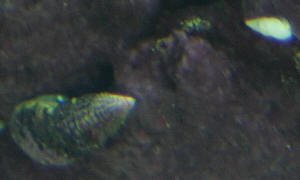 |
|
Reef Tank Worm ID: Snail Trail, Likely Cerith --
2/25/10
Dear WWM Crew,
<Hello Jennifer, Lynn here today.>
I have a couple of weird worms in my reef tank and have been
unable to identify them online anywhere. Maybe you can help.
<Fire away>
I am not exactly sure how long these worms are because they are
all squiggled up. If I were to guess, I would say anywhere
between 6-10 inches. The best way to explain them is that they
look like intestines,
<They sure do. What you're seeing is a harmless strand of
snail eggs, aka a 'snail trail'. The squiggly, looping
pattern seen here is typical of Cerith spp. snails.>
..they are white and thin, and do not appear to have much mass to
them. I have had this tank for 3 years and have never seen them
until 2 weeks ago.
<If you've had the snails for a while, it's possible
that previous trails were left in out of sight locations. Either
that, or conditions just recently became favorable for
reproduction.>
I never see them move at all.
<Nope, they wouldn't - at least not unassisted.>
Sometimes they even stay in the same place for days,
<That's typical. Strands usually remain intact for several
days, then begin to break up, detach, and disappear, becoming
part of the food chain.>
..other times I will wake up and they will have moved.
<This indicates that the strand is either starting to detach
on its own, or something has been picking at/preying on
it.>
They are out in the day and night. Here are a few photos. It was
the best I could do because these weird worms are somewhat
transparent. They also seem to prefer to hang out on the
glass.
<Again, that's typical. They're commonly deposited on
hard surfaces, mostly tank walls or rocks. Of the two, the snails
seem to prefer tank walls.>
I have not seen them on the sand
<Too soft/unstable>
..or rock. I thought they might be Spionid Hair Worms, but all of
the photos I saw online did not match what I have.
<Correct>
Thanks for your help.
<You're very welcome. For more information/photos, please
see the following link:
http://www.wetwebmedia.com/MolluscPIX/Gastropods/Prosobranch%20PIX/Cerithids/CerithF1.htm
>
Sincerely,
Jennifer C. McCaa
<Take care, LynnZ>
|
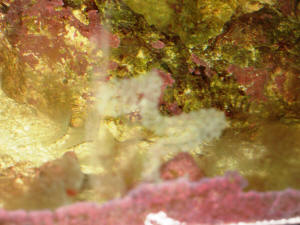 |
Re: Reef Tank Worm ID: Snail Trail,
Likely Cerith -- 2/25/10
<Hi Jennifer>
Lynn, wow that's cool.
<It sure is.>
I really thought they were some kind of worm.
<They certainly are squiggly, aren't they?>
I guess I thought those particular snails did not reproduce well in
captivity.
<It depends on the species. The larger Ceriths that we're so
used to seeing in the trade lay eggs, but unfortunately the young
rarely survive.>
My turbo snails have many times, but I have never seen this until
recently.
<It's pretty neat, and speaks well of your good
husbandry.>
And I have seen them in a few different places over the last 2
weeks. Anyway, thanks for the answer.
<You're very welcome.>
No wonder I couldn't find it under worms! LOL
<Heeee!>
Thank you,
<It was a pleasure.>
Jennifer
<Take care, LynnZ> |
|
What is this growing on my live rock?
Probable Egg Strand -- 5/28/09
Hi,
<Hi Scott>
I read through all the live rock hitchhiker pages and found a few
descriptions of what this could be but nothing with pictures.
I've got this stuff growing on 2 of my rocks that have been
in the tank for about 2 months now.
<How long has it been around - days/weeks/more?>
It looks a lot like ramen noodles but a lot smaller.
<Yep>
Any ideas what this is?
<Do you have any snails in residence - Ceriths by chance? That
looks a lot like an egg strand, possibly snail or even some kind
of slug/Nudibranch. Cerith snails leave a very similar squiggly,
loopy 'snail trail' of eggs. Please see the first FAQ,
titled 'Gastropod egg ID 8/1/05', at the following link
for an example: http://www.wetwebmedia.com/snailreprofaqs.htm .
By the way, if you don't have any Cerith snails and you'd
like to pursue an ID, please send us a livestock list and
we'll see if we can't solve this mystery.>
Thanks, Scott
<You're very welcome. Take care, LynnZ>
|
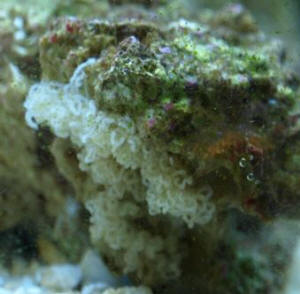 |
|
Snail/Conch ID 1/14/09
HI,
<Hi Steve>
Love the site guys! I found this guy in my tank about a year ago.
He must have hitchhiked on one of my pieces of liverock. I have
no idea what he is.
Looks like a conch of some kind to me. Can you help me ID? If so,
is he safe?
<Looks more like a Cerith Snail to me. If it is an inch or
less long, it probably is.>
Thanks.
<You're welcome. James (Salty Dog)>
Steve
|
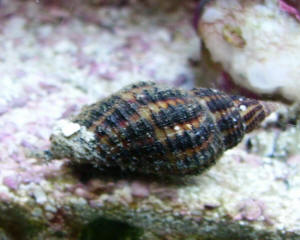 |
Substrate fears and missing Ceriths
2/26/08 Hi: I'm fairly recent to the hobby, but I've
read and read the FAQs on WWM, which are a great resource! Now I have a
problem I'm not sure is general enough that it's been answered
before For setup, I have a 55 gal system with an overflow into about a
15 gal, 3 chambered sump with a too-tiny wet/dry (which I am slowly
removing in favor of a filter sock setup which I will change out every
other day or so) and a 6 gal remote deep sand bed (just plain sand in a
dark bucket fed with a powerhead from the sump and draining back into
the sump). The system is 3 months old in the sense that that's how
long I've had it running in my house, but it's actually more of
a "moved" system, since I got it from someone leaving the
hobby who had had it up for about 2 years previous. We removed the
remaining livestock (clownfish, a single Astrea/Trochus snail (I still
can't always tell which is which) and some hermits), drained most
of the water, wrapped the LR in wet newspaper, and then refilled the
tank in its new location with fresh mixed water (Instant Ocean). After
a very short cycle and some waiting ( I expected the system to be much
more unstable, but I guess since it was an old system there was still
plenty of living bacteria in the rocks and sand), we eventually removed
the homeless livestock back in. All did well. Since cycling, my
readings have been all 0 throughout except for a nitrate level that
hovers around 15-20. <This will largely go w/ the removal of the
wet-dry media> Alk 300, ph 8.2-8.4. I haven't really measured
calcium since I don't have any coral yet. Coralline seems to be
growing fine. I have a protein skimmer (sea clone, yuck, but fiddling
with it all the time, while annoying, seems to at least get it pulling
skimmate out steadily), PC lights with actinics and moonlights, and two
Koralia circulation fans that keep things moving and suspended. Not
sure what else is relevant. <So far, me neither> My return pump
is 700pgh which goes into a rectangle pvc rim at the top of the tank
with several holes drilled in it, and the fans rate at 800gph and 400
gph. I don't know the poundage of LR, but however much it is, it
seems like a bit too much for the tank: not enough open sand for my
liking, and hard to get the fans arranged without dead spots or
building hills and valleys in the substrate over time. <Take some
out... put it in the sump> I've been thinking about selling away
a piece or two. I do water changes about once a week, usually 10gal
each time (hoping to lower my nitrates), <Mmm, will only help
nominally/proportionately... temporarily> though I've been
cutting back to 5 gal done more often. I've been using AmQuel+
treated tap water (UK: maybe this is my problem!), but I recently
invested in an RO/DI that's putting out 0 TDS, 0 chlorine, 0
anything else I've been able to test, as advertised. For too long I
was also using treated tap water for evap top off, but I figure that
this is really bad, because, as I realized, benign or no, those
chemicals and their bonded bad stuffs can only increase in
concentration over time that way. <Mmm, could be
bio-accumulated...> Hopefully I've switched soon enough to avoid
any serious problem, and my steady 5 gal changes should hopefully
dilute, dilute, dilute anything that's built up in the water column
(hopefully this stuff doesn't live forever in the rocks and glass).
<Nothing, nothing... nothing lasts forever> The substrate is a
coarse grain aragonite, though rounded and not sharp, and fairly
shallow (an inch or two). The substrate is my major concern however. It
is, obviously, old substrate from the previous setup. I have no idea
what's lurking down in it in the way of nutrients. One of my big
regrets in setting up this system the way I did was not simply
replacing the substrate entirely and starting from scratch (I guess we
didn't want to wait anymore and let more of the LR die off at the
time). I know you can always replace it, but that seems very daunting
and dangerous in and of itself. <Nah> And I fear that it's
been killing Cerith snails. Over the two months, I've gradually
added several Nassarius snails, two small Turbos, one large turbo, and
two Ceriths. <Why? I mean, towards what ends the gastropods?> My
acclimation process is to float their bag in dark of the sump for
temperature and drip acclimate, usually for 3 hours or so, before
adding them to the display. All have, as far as I can tell, thrived:
they are active and eating well, cleaning glass of both film and even
thicker fuzzy green algae in the case of the larger turbo. The two
Ceriths, however, moved very little at first, and then died within days
(confirmed by smell and not either closing up or coming out). I
wasn't sure why, when everything else seemed fine. <Could be a
few things... posted> One of the Nassarius, after more than a month
in the tank, seemed to become weak, hang out on the glass (is that a
diagnosable behavior?), <As itself, no> and seemed to have a
little white pus on its underside shell next to its foot (though this
could have just been muck from burrowing: hard to tell). It finally was
moving enough to turn itself over, but it wouldn't move to take
nearby food (a skewered piece of shrimp dipped in on a plastic stick:
the other snails swarmed it and sucked it apart). The next day, its
shell was empty... except for a small bristleworm cleaning things up. I
wish there were better resources for diagnosing snail illness: I enjoy
them more than fish, but there seems to be little out there on diseases
or common problems: people treat them like disposable "clean up
crews" instead of critters. The next sign of trouble was the
recent addition of four Cerith snails (each about an inch from head to
tip, and a different species than before: the first two were darker and
fatter shells, these were long and rocky gray), three weeks ago. Or
rather, there were no signs of trouble that I could see... After
acclimation, they quickly burrowed into the substrate. I checked every
night with a red LED (small bike lights work great!) <Neat tool
application> to see them come out: I like to get an eyeball on every
major creature in my tank at least once a day to see how its doing.
They seemed fine: I couldn't always find all four, but with all the
LR I have and the many spaces in the back where there is sand I
can't see, that wasn't surprising. They would come out of the
sand about an hour after dark, eating at the bottoms of the LR,
climbing on it, and once or twice climbing the glass. All were eating
and strong enough to stick to the glass even in areas where my
circulation fans had strong reflected current. But after a few days
there were fewer and fewer sightings, though when I did see one, it
seemed fine. In the last two weeks though, I haven't seen any,
despite checking at all hours of the night and day (literally). Someone
on a message board suggested dropping a sinkable veg pellet in at
night, said that their Ceriths would come out and swarm such a thing.
Well, my Nassarius went crazy, but no sign of the Ceriths. I've
also watched the substrate carefully for any "tracks" that
suggest that I was somehow missing them. Nothing: no visible evidence
of them coming and out. At this point I'm working under the
assumption that they are dead. <I wouldn't be so sure> Which
is a problem. What could kill all four of one kind of snail in a tank
where everything else seems happy? <... Please read here:
http://wetwebmedia.com/snaildisfaqs.htm and the linked files... Could
be a chemical imbalance (very common), predator (a bit less
common)...> Why wouldn't other snails die or show illness as
well? <More tolerant of the root cause/s of mortality...> The
Ceriths burrow far deeper into my substrate than the Nas snails (most
of which seem to have mostly given up complete submersion), and I'm
really worried that what killed them was something toxic down there.
I'd like to find their bodies to confirm (and also, if they are
dead, to at least have the shells for hermits to try on) that they are
dead and maybe some insight into how, but I'm loathe to go poking
around in the substrate for fear of stirring up whatever might have
killed them. I do have small hermits, but I figure that if they killed
them (and they haven't bothered any other snails) that they'd
either be wearing their shells already, or at least that the remaining
bodies would be above ground rather than nowhere to be found. So now
I'm quite worried: worried that I have killer substrate, but having
no idea how to confirm it, or what to do about it. There's no
"rotten egg" smell I can discern or any other obvious sign. I
lightly siphon above substrate to remove debris (some of which is odd:
long before the Ceriths I get little discrete piles of fine beige
grains, much lighter than diatoms: piles of copepod molts maybe)? And
nothing else seems to be in distress. The hermits have been reproducing
(shaking what look like live bees off their back), which the clown
always quite enjoys, Nas seem to periodically lay their doomed eggs on
the glass, which pods probably enjoy, there are red hair worms living
in the sand, small bristleworms that come out at night, some peanut
worms (maybe? All I ever see are strange pale tubes coming out of
sand/rock that seem to suck up bits of things and then you can see it
traveling slowly down their length), and for a time even a huge
spaghetti worm (with tentacles up to a foot long: this has, much to my
disappointment, either since moved out of obvious sight or died). I
suppose I could have gotten snails that were all four somehow damaged
the same way, or did something wrong acclimating them. <Happens>
But there didn't seem to be any problems I could diagnose, and
these are the second set of Ceriths (though not the same species) to
either die or vanish. Is there something I'm missing about keeping
this animal? What should I do to find out what happened to them? Are
there any husbandry things I can do, or things I can test or check to
find out if I'm at fault? <I would "take a chill pill"
here... Not worry, not replace this genus/snail...> I know I went on
and on, but you said to be detailed, and I hope I was detailed enough.
Thanks for any help. <Enjoy the reading, your system. I might
add/switch out some of the old substrate... as recounted on WWM. Bob
Fenner>
| Can You Identify This For Me? Snail Eggs, Likely Cerith
-- 8/28/08 <Hello Liz, Lynn here this evening.> I
have this white thing in my tank. At first it was in one place, and
then this morning I see it in a totally different place. Can you
tell me what it is? <It looks like what's commonly called a
'snail trail', a harmless, looping/squiggly, rope-like
strand of snail eggs. By any chance do you have any Cerith snails
in your tank? They lay eggs in patterns just like this. The strands
tend to last for several days then simply disappear, becoming part
of the food chain. It sounds like you either had two separate snail
trails (and the first was eaten), or the first strand came loose
and snagged at the second location. It's not at all uncommon
for this to happen. I'd love to be able to tell you that
you'll soon be seeing baby snails cruising about, but
unfortunately, the young have very little chance of surviving. On
the plus side though, it speaks well of your husbandry techniques.
Good job! Thank you Liz <You're very welcome. Take care
--Lynn> |
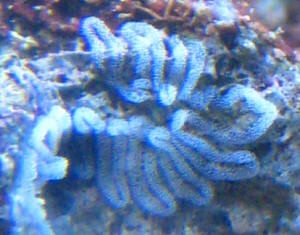 |
|
Mystery "thing": Eggs - 6/2/07
Folks, <Hi Pete> You have been MUCH help to me in this
hobby so far, from the excellent information presented on the
website to the returned emails - thank you. <You're very
welcome, and thank you indeed for the kind words.> I noticed
this "thing" attached to the spray bar in my reef tank.
I have NO CLUE what this might be. Even after searching through
you site - I couldn't get an Id. Do you have any clue as to
what this is? <It appears to be eggs. I can't quite get a
size reference, but the squiggly pattern looks very similar to
what you see with Cerith snails. By chance do you have any in
your tank? If not, with a little more information regarding size
and what livestock you have, we might be able to figure it out.
At any rate, there's no cause for concern. It's a good
sign that you've got some happy inhabitants!> Should it be
removed? <No need.> Please ignore the date stamp - it's
wrong - this pic was taken 06/02/2007. <No problem.>
Thanks. --Pete <You're most welcome! -Lynn>
Re: Mystery "thing": Eggs -
6/3/07 <Hello Pete! Lynn here again.> Yes I do have
Cerith snails! Well then that explains it. <Yay!> Thank you
so much, it was driving me crazy trying to figure out what that
was. <I know just what you mean. When something mysterious
pops up in your tank, it's good to know what it is. Finding
out that it's no cause for concern is even better!> My
assumption is they may hatch and become a food source?
<Yes.> Yellow-tail blue damsel, yellow tang, tomato clown,
urchin, some snails, hermits, and a couple corals are in the 75
gal tank. Again - a sincere thank you for your time.
<You're very welcome! -Lynn>
|
|
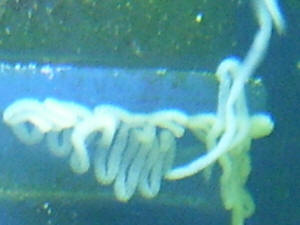
|
| Snail ID 3/28/07 Sorry. I forget to attach
the pics. These are the pictures. It's a bit blur. Hope you
don't mind. <Pics are blurry, but my guess would be same as
yours, a Cerithium.> Thanks. <You're welcome. James
(Salty Dog)> |
|
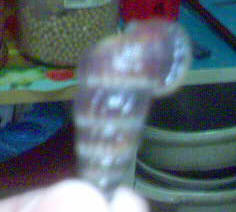 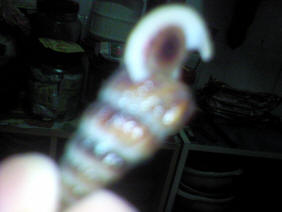
|
- Cerith Snail Question - I have a question about one of my
Cerith snails (Cerithium vibex, I think maybe litteratum). I have
nearly a hundred and although they spend most of their time in the
sand, occasionally they'll crawl up on the glass so I can get a
good look at them. Today I noticed something very odd about one of
them. It appears to have tiny threads protruding from all over it's
body. They are pink, and I mean pink pink, and about the size of a
human hair. Each strand extend straight out from the shell for about a
cm and then splits into a little polyp of several shorter threads. It
looks a lot like a star-polyp, only smaller, and, of course, on the
shell of a snail. There has to be at least four dozen of these polyps
all over this one Cerith. It occurred to me this may just be some kind
of growth on the shell and in no way connected to the creature inside,
but none of the other snails have even a single polyp, nor do any of
the loose shells on the bottom. Also, I can't find this stuff
growing anywhere else in the tank, and I've yet to really stock it,
so there's nothing obscuring the rock. Anyways, so what do you
think? <I'd agree... this is localized to the one snail, which
isn't all that unusual... not sure exactly what the growth is, but
sounds like perhaps hydroids. A picture would be worth 1,000 words.>
Thanks, Dekon <Cheers, J -- >
Pods attacking snails? 06/11/05 Dear WWM crew; Hello, and
hope you are doing well. <SUP> I really enjoy your website.
<<Thank you :)>> Two quick questions for you guys. Today I
was looking at my tank and saw two copepods possibly attacking a Cerith
snail. I could see right away that the snail was not dead, it was
cruising around eating as usual. The two copepods were running around
and over the snail's shell, and then one of them stopped and
lingered for a moment on the snails foot. The snail didn't seem
affected at the time, and its been about three hours since it happened
and the snail is still behaving normally. So my question is, would
copepods attack a live snail, or was it not an attack at all and I am
just being paranoid? << Paranoid :) They are probably just
picking at the algae on the shell of the snail or around its base. No
worries. >> Also, how capable are Cerith snails of righting
themselves if they end up on their backs somehow? Could it be fatal, or
am I just being paranoid again? << Paranoid :) Cerith snails
definitely can upright themselves. It is cool to watch. The come almost
completely out of their shell and grab the sand bed. Then they spin
their shell around to make them upright. Astrea snails are the common
snails you see in stores with a Chinese hat shape that cannot right
themselves. So if you do not flip an Astrea snail over it will die
>> Thanks in advance. Love, Adam G. Mesa, AZ << Thanks for
the support.. EricS >>
Spawning Snails Hi, I was wondering if I would be correct in
assuming that if/when Cerithidae deposit eggs that the eggs appear as a
whitish squiggly scroll no bigger than maybe .5 square inches?
<Many, yes... some a bit larger, different colors... largely
depending on what the individuals have been feeding on.> I found
these at the surface of my reef almost out of the water) where I often
see the snails. I've also found them attached to fronds of Caulerpa
algae, which brought to mind the thought of possibly harvesting, and
rearing. The Ceriths in my tank where a lucky bonus with my live rock,
and their numbers are naturally increasing slowly), which is fine for
my tank. I, guess that my question would be... Is there a way/system
for increasing yields. I would like to be able to raise enough of these
snails to maturity to stock other tanks. <Possibly... food items,
lack of predators, competitors... Trial and error I think are what
I'd attempt.> I included a picture of my reef, that I'm
proud to say is stocked inverts) solely with cuttings from other tanks.
a big advantage to being a member of the local aquarium society!) the
only wild stuff other than the live rock, is the little exotic
blue/yellow Pomacentridae I "rescued" from the store.
<Very nice, and good to hear.> Thanks for your time, any
information is greatly appreciated. Sincerely, Cleve R. Burd Pgh, Pa.
<Take a look through the WWM site: Home Page re doing computerized
bibliographic searches, and get thee to a large college library...
There are, little doubt, recorded observations of others that can/will
aid you in your culture work. Bob Fenner>
| Odd white pattern on live rock Dear folks,
<Howdy> Thanks in advance for your time. I was just looking
at my tank and noticed an odd pattern in two locations on my live
rock. It is white and looks like it is made up of mini bubbles or
something. It is very squiggly and the pattern is extraordinary
regular. Without a digital camera, I am forced to send a poor
computer drawing. I know that my drawing stinks, but really, the
design is like this only each loop is exactly the same and very
close together but not touching. I thought it might have come from
the margarita snails ( I have 3) But I am not sure. I also have a
bunch of Cerith snails, 2 clowns and a few hermit crabs. Thanks,
Steve <Drawing looks fine, and I do agree with your suspicion.
This is likely a "snail trail". Nothing to be concerned
about... as the system goes/grows, other organisms will come into
being, preponderance that the snails don't denude. Bob
Fenner> |
|

|
|
Not a Question Actually, this isn't a question...on
the Snails FAQ 2, the question titled Odd white pattern on live
rock -- those are Cerith snail eggs. I have pics of one in the
process of laying eggs if you'd like a copy... <Thanks
much for this. Will amend (my evil ways, no, actually just this
label) on the morrow> SushiGirl <Ooh, and I like that name.
Bob Fenner>
|
|
|

